Radiologia Brasileira - Publicação Científica Oficial do Colégio Brasileiro de Radiologia
AMB - Associação Médica Brasileira CNA - Comissão Nacional de Acreditação
 Vol. 48 nº 1 - Jan. /Feb. of 2015
Vol. 48 nº 1 - Jan. /Feb. of 2015
|
ORIGINAL ARTICLE
|
|
Dose calibrator linearity test: 99mTc versus 18F radioisotopes |
|
|
Autho(rs): José Willegaignon1; Marcelo Tatit Sapienza2; George Barberio Coura-Filho3; Alexandre Teles Garcez4; Carlos Eduardo Gonzalez Ribeiro Alves5; Marissa Anabel Rivera Cardona6; Ricardo Fraga Gutterres7; Carlos Alberto Buchpiguel8 |
|
|
Keywords: Nuclear medicine; Dose calibrator; Linearity test; Nuclear instrumentation. |
|
|
Abstract: INTRODUCTION
Dose calibrator is an indispensable equipment in the field of nuclear medicine, and is widely utilized in the measurement of radioisotopes quantities to be administered to patients both in diagnostic and therapeutic procedures. For evaluation and proper maintenance, such an equipment must be routinely submitted to performance tests, particularly the linearity test(1). Such a test is aimed at evaluating whether the equipment maintains its capability of measuring the radioisotopes activities in different magnitudes, as the quantities utilized in diagnostic and therapeutic procedures may differ by orders of magnitude. Several studies in the literature indicate the relevance of the linearity test and the technical procedures for its implementation(1-4). Such a test is aimed at evaluating the linear response of the equipment produced by different activities of a given radioisotope, from a source with an activity close to the minimum resolution of the measurement system (MBq) to a high activity source (GBq). In practice, generally one starts with a high activity source, which will decrease according to the radioisotope physical decay. Although the linearity test may be performed by utilizing different radioisotopes, technetium-99m (99mTc) has been the element of choice due to its short physical half-life (6 hours), wide availability, low cost and for being the element with higher representativeness at nuclear medicine clinics. On the other hand, the increasing number of clinics dedicated to positron emission tomography, relying mainly on fluoride-18 (18F), has led to questions on the possibility of the utilization of 99mTc in linearity tests at such clinics, with a view on the high acquisition cost of 18F. Based on the above mentioned factors, the main objective of the present study is evaluating the use of 99mTc and 18F radioisotopes in linearity tests, comparing results and indicating the radioisotope of lowest operational cost for nuclear medicine clinics. MATERIALS AND METHODS The linearity test was performed utilizing 99mTc and 18F sources in a CRC-25R dose calibrator, serial number 252090 (Capintec Inc., USA) of the Nuclear Medicine Service of Instituto do Câncer do Estado de São Paulo Octavio Frias de Oliveira (Icesp). Such an equipment is based on a pressurized ionization chamber, with suitable characteristics for utilization in the field of nuclear medicine. Previously to linearity tests, precision, accuracy, source geometry tests and daily controls were performed in the dose calibrator, assuring the good quality of the equipment before starting the study. The initial activity of the 99mTc source (62 GBq) was obtained by means of 99Mo/99mTc generator elution process, number 350IP0039, acquired under purchasing procedure from Instituto de Pesquisas Energéticas e Nucleares (Ipen). The 18F source (initial activity of 12 GBq), lot 131213-0101, was acquired by donation from Ciclotron of Instituto de Radiologia do Hospital das Clínicas da Faculdade de Medicina da Universidade de São Paulo. Both sources were in the liquid physical state, with respective volumes of 6.0 mL and 2.5 mL, in glass vials. The 99mTc source was measured along five days while the 18F source was measured along two days, starting from the initial activities of 62 GBq and 12 GBq, respectively, obtaining 13 measurement spots for the 99mTc source and 10 spots for the 18F source. The activity considered for each measurement spot corresponded to the arithmetic mean of five measurements. The 99mTc activity as well as that of 18F were measured until the activities reached values compatible with the lower resolution of the measurement system, indicated by the manufacturer (∼ 1 MBq) and in accordance with the minimum activity to be utilized in the test and indicated by different recommendations(4-7). The method adopted to evaluate dose calibrator response linearity in relation to the variation of the sources activities was the decay method, which consists of measuring the activity of a given source along time, allowing for the plotting of the "activity versus time" curve and the comparison of the experimental activity values with the expected theoretical values for the source at the different measurement times. The calculation of the theoretical activities took into consideration the physical half-life of both 99mTc (6 hours) and 18F (1.83 hours)(6). The acceptable limits for deviation between the theoretical and experimental values were ± 5% and ± 10% in accordance with recommendations from International Atomic Energy Agency (IAEA) and standards of Comissão Nacional de Energia Nuclear (CNEN)(3,4,8). Both the 99mTc and the 18F sources were measured with the equipment being pre-adjusted for the measurement of 99mTc sources (99mTc "window") and subsequently for 18F sources (18F "window"), thus allowing for the comparison of detector response for the same radioactive source when measured at different radioisotope windows. The acquisition costs of the 99mTc and 18F sources necessary for the linearity tests were also estimated. In the present study, as necessary, some data are presented as mean value ± 1 standard deviation. RESULTS Successive measurements of the 99mTc and 18F sources have experimentally demonstrated the variation of their activities over time as result of the radioactive decay process. All the experimental measurements and the ratios between such measurements are presented on Table1, and the trend lines for the obtained values can be observed on Figures 1, 3, 5 and 6. The deviation value presented on the table corresponds to the deviation between the experimental activity value acquired by means of the dose calibrator and that estimated for the source by means of calculation for the same time span. 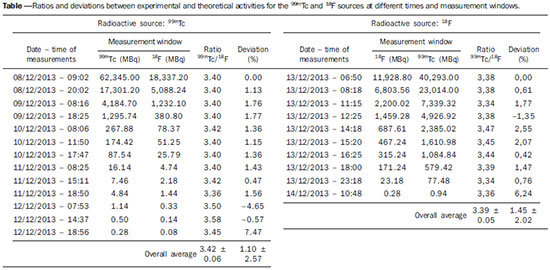 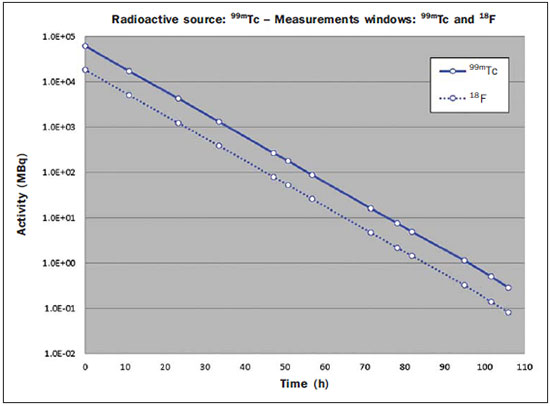 Figure 1. 99mTc source activity decrease as a function of time as measured in the 99mTc and 18F windows. 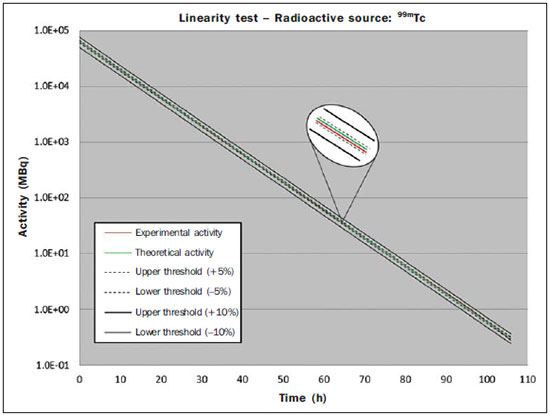 Figure 2. Characteristic chart of the linearity test performed with the 99mTc source, indicating the upper and lower thresholds of acceptable deviations for the purpose of this testing. 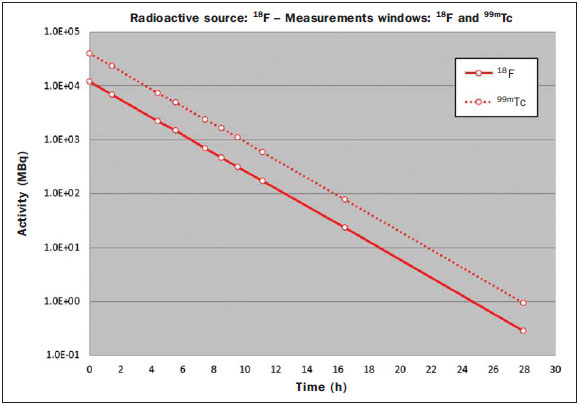 Figure 3. 18F source activity decrease as a function of time as measured in the 18F and 99mTc windows. 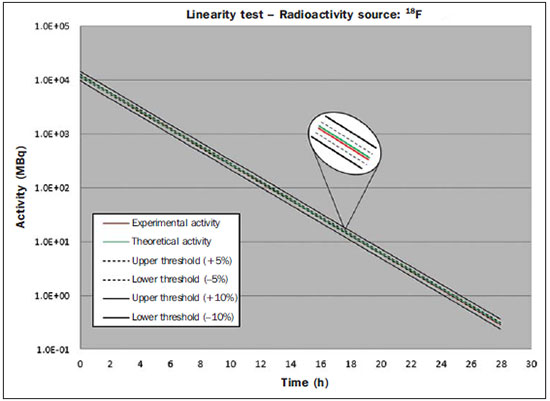 Figure 4. Characteristic chart of the linearity test performed with the 18F source, indicating the upper and lower thresholds of acceptable deviations for the purpose of this testing. 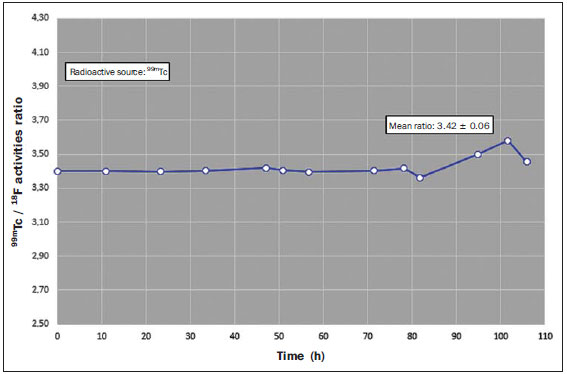 Figure 5. Ratio between activity values indicated by the dose calibrator for a 99mTc source as measured in the 99mTc and 18F windows. 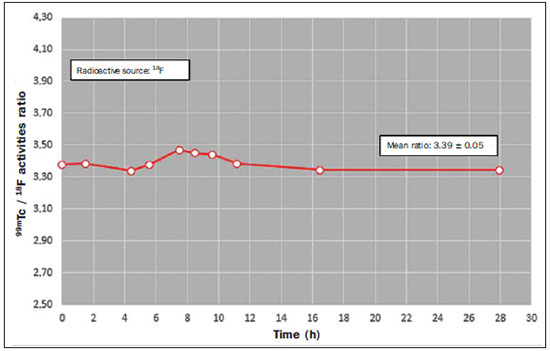 Figure 6. Ratio between activity values indicated by the dose calibrator for a 18F source as measured in the 99mTc and 18F windows. Because of the good precision of the equipment, the standard deviation presented in each measurement series corresponded to approximately 1% of the mean value for that set of measurements. It is important to emphasize that the experimental activities indicated on the table and figures represent the mean value of a series of five measurements, but the measurements standard deviation (approximately 1% of the mean value) was not indicated in order not to impair or confuse the visual analysis of the charts and table. Figures 2 and 4 represent the characteristic charts of the linearity test, indicating the relationship between the experimental and theoretical values of the 99mTc and 18F activities as a function of time, as well as the lower and upper acceptable limits for the test in accordance with the IAEA recommendations and CNEN standards. The mean deviation between the experimental and theoretical activities for the 99mTc and 18F sources were, respectively, 1.10 (± 2.57)% and 1.45 (± 2.02)% and the maximum values observed were 7.47% for the 99mTc source and 6.24% for the 18F source, both values located at the lower resolution limit of the measurement system (< 1 MBq). For activity levels greater than the lower resolution limit of the system, the mean values of the deviations were 0.56 (± 1.79)% for the 99mTc source and 0.92 (± 1.19)% for the 18F source, indicating an excellent quality of the system in the measurement of different activity quantities of a same radioisotope. The adjustment of an exponential function of the y = a + beλt and λ = 0.693/T1/2physical types, for the experimental data for the 99mTc and 18F sources allowed for the calculation of the physical half-life for both elements, whose values were, respectively, 5.949 (± 0.002) hours and 1.816 (± 0.007) hour with a difference of less than 1% from values reported in the literature(6). The mean ratio between the activities indicated by the equipment for the 99mTc source when measured at the respective 99mTc and 18F windows was 3.42 (± 0.06) while for the 18F source was 3.39 (± 0.05). Such ratios were considered constant throughout the entire measurement period (Table 1) implying the possibility of utilization of both radioisotopes in the linearity test, independently from the window utilized to measure the source, as the linearity test aims at evaluating the equipment response in the measurement of different activity quantities, whose response should be linear in the interval between the lower and upper limits of activity utilized at the nuclear medicine clinic on a daily basis(4). As regards costs, the acquisition cost of a 99Mo/99mTc generator with 6.75 GBq (250 mCi) for the performance of the linearity test is about R$ 1,300.00, while a 18FDG source with 6.75 GBq (250 mCi) amounts to approximately R$ 3,500.00, according to a 2014 inquiry to Ipen, an organ of CNEN and main radioisotopes supplier in the Brazilian market. DISCUSSION The electric current generated at an ionization chamber-based dose calibrator, which is proportional to the activity, is related both to the quantity of radioactive atoms existing at a given sample and to the photons energy released during the disintegration process. The same electric current per activity unit (pA/MBq - picoampere per MBq) may be obtained from different radioisotopes, a fact that hinders the identification of the radioisotope by the dose calibrator during the measurement process. Thus, in order to obtain a reliable reading from the dose calibrator it is necessary to enter correction factors for the electric current proportional to the radioisotope to be measured, and that is automatically obtained by means of the radioisotope selector that exists in the equipment. Generally, the correction factors between a given radioisotope and another are constant, taking as a reference the radioisotopes utilized by the manufacturer in the initial calibration of the equipment, such as the 60Co and 137Cs(2) radioisotopes. Usually, the linearity test provides good results within acceptable parameters, provided the characteristics of the measurement system, such as good precision, accuracy and daily constancy testing are properly maintained. In the present study, the tests were carried out with 99mTc and 18F sources and in both cases the excellent quality of the equipment was independently demonstrated by measuring different activity quantities from radioisotopes with quite distinctive energies, namely 141 keV (99mTc) and 0.511 MeV (18F)(6) (Figures 2 and 4). The practically constant ratio between the activities indicated by the equipment for a same source measured at different windows (Table 1; Figures 5 and 6) allows for the demonstration that the utilization of a single radioisotope, for example, 99mTc, could be enough for the performance of the linearity test, independently from the utilization of 18F, either exclusively or not, by the nuclear medicine clinic. Conceptually, the response from a dose calibrator is considered to be linear whenever the measured response/estimated response ratio or deviation remains constant along time, a fact that was experimentally demonstrated in the present study (Table 1)(5). Additionally, the linearity test evaluates the ionization chamber's saturation characteristics, as well as the electrometer linearity in the electric current measurement. Therefore, the linearity test is not directly linked to the utilized radioisotope, but rather to the amount of electrical loads generated during the measurement process. Thus, the linearity test could be performed with different radioisotopes provided the electric current interval, proportional to the activity interval to be tested are within the limits applied at the nuclear medicine clinic. Such information is very important and useful for those clinics operating exclusively with positron emitters, as is the case of 18F. The AAPM Report No. 181(5) has indicated that the elements of choice for performance of linearity tests have been 99mTc and 18F, considering that routine tests with all available radioisotopes are not practicable. There is also evidence that there is a lack of consensus on the activities to be utilized in the test, a situation where some entities recommend the performance of tests with activities within the interval where the dose calibrator will be utilized, while others such as IAEA recommend the test to be initiated with the maximum activity administered to the patients in the clinic routine, although all of the entities are in agreement that the minimum activity to be tested should approach the resolution values of the measurement system (∼ 1 MBq)(5). However, one should consider the fact that not every measured activity will be administered to patients, such as, for example, the activities that will be stored as liquid radioactive waste and, in this particular case, the correct measurement of the activity is a very important factor impacting the storage time span of such waste. The difference in costs for the performance of the linearity test either by utilizing 99mTc or the 18F radioisotopes is very significant, reaching a 40% difference between the two radioisotopes. A viable option for further reduction in costs would be the supply of de 99mTc activities by the radioisotope purveyors with the single and exclusive purpose of being utilized for linearity testing. In this context, an inquiry to Ipen for the supply of a 13.5 GBq (500 mCi) 99mTc activity resulted in a cost lower than that of a generator, or even free of any cost, depending on favorable logistics, thus sharply impacting the cost of the linearity test. It is also important to emphasize that the utilization of 99mTc sources instead of 18F sources implies a reduction in the potential occupational and environmental exposure, as a 18F source presents a dose potential 10 times higher than that of a 99mTc source with the same activity, namely, 135.1 µGy/GBq.m2.h and 14.1 µGy/GBq.m2.h, respectively(9). The present study demonstrated the possibility of optimizing dose calibrators linearity testing, drawing the attention of investigators and regulatory agents towards a careful evaluation of the present data, as the dissemination of such information might translate into cost reduction for both private and public health services, without impairing the continuous development of the quality of services rendered to society. CONCLUSION The physical characteristics of the dose calibrator utilized in the present study allow for the indication that the results obtained in the linearity tests with 99mTc can be validated for the utilization of 18F. Such a result extrapolation, presumably extensible to other apparatuses of similar configuration and in satisfactory conditions of utilization, in association with the high exposure potential and acquisition cost of 18F, suggest that 99mTc could be utilized for linearity tests in clinics that utilize 18F, without impairing the procedure as well as the assurance of the nuclear medicine service quality. REFERENCES 1. Zanzonico P. Routine quality control of clinical nuclear medicine instrumentation: a brief review. J Nucl Med. 2008;49:1114-31. 2. Prekeges J. Gas-filled detectors. In: Prekeges J, editor. Nuclear medicine instrumentation. Burlington, MA: Jones & Bartlett Learning; 2011. p. 3-16. 3. International Atomic Energy Agency. Quality control of nuclear medicine instruments 1991. IAEA-TECDOC-206. Vienna: International Atomic Energy Agency; 1991. 4. International Atomic Energy Agency. Quality assurance for radioactivity measurement in nuclear medicine. Technical Reports Series No. 454. Vienna: International Atomic Energy Agency; 2006. 5. American Association of Physicists in Medicine. The selection, use, calibration, and quality assurance of radionuclide calibrators used in nuclear medicine. AAPM Report No. 181. College Park, MD: American Association of Physicists in Medicine; 2012. 6. Gadd R, Baker M, Nijram KS, et al. Protocol for establishing and maintaining the calibration of medical radionuclide calibrators and their quality control. Measurement Good Practice Guide No. 93. Middlesex, UK: National Physical Laboratory; 2006. 7. Sokole EB, Płaschínska A, Britten A, et al. Routine quality control recommendations for nuclear medicine instrumentation. Eur J Nucl Med Mol Imaging. 2010;37:662-71. 8. Brasil. Ministério da Ciência, Tecnologia e Inovação. Comissão Nacional de Energia Nuclear. Requisitos de segurança e proteção radiológica para serviços de medicina nuclear. CNEN NN 3.05. Comissão Nacional de Energia Nuclear; 2013. 9. Ninkovic M, Raicevic JJ, Adrovic F. Air kerma rate constants for gamma emitters used most often in practice. Radiat Prot Dosimetry. 2005;115:247-50. 1. PhD, Head Physicist at the Service of Nuclear Medicine of Instituto do Câncer do Estado de São Paulo Octavio Frias de Oliveira (Icesp), São Paulo, SP, Brazil 2. Private Docent, Professor, Department of Radiology and Oncology, Faculdade de Medicina da Universidade de São Paulo (FMUSP), São Paulo, SP, Brazil 3. MD, Physician Assistant at the Service of Nuclear Medicine of Instituto do Câncer do Estado de São Paulo Octavio Frias de Oliveira (Icesp), São Paulo, SP, Brazil 4. Physicist at the Service of Nuclear Medicine of Instituto do Câncer do Estado de São Paulo Octavio Frias de Oliveira (Icesp), São Paulo, SP, Brazil 5. Master, Technologist, Comissão Nacional de Energia Nuclear (CNEN), Rio de Janeiro, RJ, Brazil 6. PhD, Technologist, Comissão Nacional de Energia Nuclear (CNEN), Rio de Janeiro, RJ, Brazil 7. PhD, Department Head, Comissão Nacional de Energia Nuclear (CNEN), Rio de Janeiro, RJ, Brazil 8. Private Docent, Full Professor, Department of Radiology and Oncology, Faculdade de Medicina da Universidade de São Paulo (FMUSP), São Paulo, SP, Brazil Mailing Address: PhD. José Willegaignon Avenida Doutor Arnaldo, 251, 4º Sub-solo (Medicina Nuclear), Cerqueira César São Paulo, SP, Brazil, 01246-000 E-mail: willegaignon@hotmail.com Received March 12, 2014. Accepted after revision July 28, 2014. Study developed at the Service of Nuclear Medicine of Instituto do Câncer do Estado de São Paulo Octavio Frias de Oliveira (Icesp), São Paulo, SP, Brazil. |
|
Av. Paulista, 37 - 7° andar - Conj. 71 - CEP 01311-902 - São Paulo - SP - Brazil - Phone: (11) 3372-4544 - Fax: (11) 3372-4554